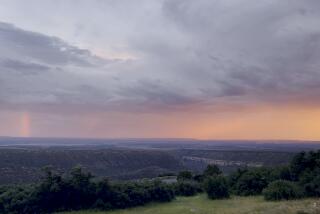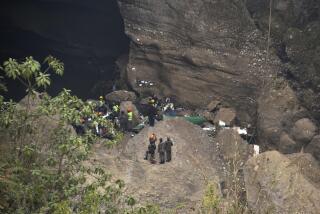Vacation Memories : Finding a Face in Nepal From Out of the Past
- Share via
KATMANDU, Nepal — After a year in Bangkok I was in the mood for someplace truly exotic. I had tried Japan, South Korea, Taiwan and Hong Kong. All of them somehow reminded me of home: Kentucky Fried Chicken. Tall buildings. Rush-hour traffic. Panty hose.
Now, two months before the Pentagon was to ship me back home, I had 10 days of leave still on the books and I called on what passes in Thailand for a travel agent.
He suggested Nepal. Thai International Airlines had a 10-day package, and it was a bargain.
It sounded like just what I needed. A perfect photo expedition. I could shoot the Himalayas. I would find medieval streets with no signs in English, no American tourists, no Coca-Cola. And I knew no one who had been there.
Our DC-8 left Don Muang Airport on a hot, sunny morning. Visions of yurts and yaks filled my head. My daydreaming was interrupted when the pilot announced that we had reached cruising altitude. The pilot’s announcement reassured and annoyed me simultaneously. I was glad to hear an American voice coming from the cockpit, but I felt less like the lone pioneer that I wanted to be.
We touched down in Calcutta for a one-hour layover. Out the window I saw an army of men pushing food and baggage carts across the Tarmac, hard labor that tractors had taken over elsewhere in the world, and I knew that Nepal was going to be even more primitive. I could hardly wait.
As we flew northeast from Calcutta I began to see the rugged, snowcapped mountains that cut off Nepal from the rest of the world. We approached Katmandu through a cloud bank, heightening its mystery--and my own excitement.
After I passed through customs a Nepalese man called out my name. He was in his early 20s and thin. He spoke a formal, British English with a heavy accent. He was accompanied by a short, squat, dark-skinned man who nodded and said OK to everything I said. The first Nepalese, it turned out, was my guide and the second was my driver.
To my delight, I learned that I was the only person signed up for the tour. Then concern. Why only me? Did everyone else in Bangkok know something I didn’t? I decided to be cautious. Keep my guard up. Be careful what I said and to whom.
As we drove from the airport to the Annapurna Hotel where I would be staying, the sights and sounds came as a shock. It had taken me three months to adjust to Thailand. But Nepal!
In comparison, Thailand was an advanced industrial society. Cattle roamed the streets and lay on the sidewalks. Women filled tall pots for drinking water from outdoor faucets. Temples painted with ominous eyes stared at me from every direction.
I was reminded of an expression I had heard a few weeks earlier: “Nepal is rushing into the 14th Century.” It seemed apt.
As a serious amateur photographer I found that the city offered me one surprise after another. The people’s dress and scenery presented wonderful photo opportunities.
I visited temples and other basic tourist attractions with my guide. I even rose at 4 a.m. to watch the sun rise over Mt. Everest in the dry, cold air of morning while boys selling daggers and water pipes swarmed around me.
But I most enjoyed simply walking around the city on my own and taking candid pictures of the people in a most unobtrusive way. A long telephoto lens allows one to capture the natural scene undetected.
Impolite Photography
It is terribly impolite and possibly dangerous to stick a camera into a stranger’s face. You also lose the natural, spontaneous expressions that you wish to capture on film. But if you stand casually beside a tree, bush or fence with a 200-millimeter zoom lens, you can snap great pictures while remaining undetected.
Roaming the streets one day, I came upon an expansive public park. A long fence about three feet high ran parallel to the street. Inside the park nearly 400 people sat in a semicircle, facing a speaker whose back was against the fence. All seemed intent on what he was saying.
As I walked by I saw many unusual faces and thought this would be a great chance to get some excellent character studies. I hurriedly set up my camera and tripod and began to scan the crowd.
I thought the speaker was some kind of guru. He spoke at times in Nepalese and at other times in English. I was not really interested in what he was saying but rather in the people to whom he was talking and their reaction to his words. For the most part, they sat quietly on the ground, bunched together, straining to catch each word as if in deep concentration.
There were wonderful faces of old men with long beards that began to fill my camera’s viewing screen. The creases and lines of a face in deep concentration are a delight to a photographer. Mongol and Han Chinese heritages were etched in these wizened old faces.
My mind raced ahead about how I would print these pictures and how proud I would be. Then, I saw a group of Westerners at the fringe of the crowd, four young people--two men and two women. Although they were dressed in local garb, they were clearly American.
I quickly shot a few pictures of the four and zoomed in to take individual pictures, slowly, one by one. They noticed me and became uncomfortable. Not simply annoyed, but rather suspicious. They began to squirm and to turn sideways, which, of course, gave me the chance to get good profile shots.
One woman in particular seemed most bothered. She appeared to be in her mid-20s, and I had a peculiar feeling that I had seen her before. The more I became convinced that she didn’t want her picture taken, the more fascinating I found her.
The four conferred with each other, suddenly got up, turned their backs to me, and began walking quickly toward the farthest exit of the park. I decided it would not be prudent to follow them and figured I had enough pictures anyway, and began to pack my things.
Asking Questions
As I was putting away my tripod an American in his mid-20s approached me and began asking questions. He was accompanied by 15 Nepalese. He was either an extraordinarily friendly guy or was trying to pump me for information.
Who was I, he wanted to know. What was I doing here? What were my plans? And mostly, where was I staying? He spent a good deal of time trying to convince me to go to a religious meeting with him at 8 that night, and would not take no for an answer.
Although I could not be sure that he was connected with the group of Americans I had just photographed, I decided it was probably more than coincidence. I realized that the less I said, the better. Believing that flight is the better part of valor, I made a vague excuse and dashed into a taxi.
I had the driver take a circuitous route to my hotel, as the only training I’d had was watching TV detective movies and remembering that is what they did.
Safe in my hotel room, I began to unwind. I had a small tape recorder to document my impressions of the trip to Nepal. I felt that this would be the time to begin recording my thoughts, especially in light of what had just taken place. I began to recount the events of the last two hours.
Speaking into the tape recorder, I found that it was easier to sort out my thoughts. But more questions kept emerging. Who were these Americans? And who was that young woman? It was clear to me that she, in particular, was more adamant than the others in not wanting to have her picture taken. She, in particular, hid her face.
Halfway around the world from home, she must be a nationally noted figure. A fugitive. And why did her face look familiar? A clear picture began to take shape. As an avid reader of Time, Newsweek and newspapers, I sat back, closed my eyes and searched my memory.
Whisper of an Idea
A whisper of an idea began to emerge from my unconscious. A town house in Manhattan. Blown up by the Weather Underground. 1970. Three people killed in the explosion. A woman was blamed. A woman from an unlikely background. An honors student.
Was it, indeed, the first woman ever placed on the FBI’s most-wanted list? Bingo! That was it! I had seen one of the 10 most wanted criminals in the United States.
I probed more deeply into my memory. The name came into my mind.
After I returned to Thailand I felt it to be my duty to turn the information and pictures over to military intelligence who, in turn, transferred the information to Washington. I was notified that her identity was confirmed, and I was thanked for my efforts.
This woman surfaced in 1980 after nearly 11 years in hiding. During a dramatic trial she pleaded not guilty to charges of violation of federal anti-riot laws and unlawful flight to avoid prosecution for mob action.
She was fined $1,500 and given a three-year suspended sentence. The next year she went to prison for refusing to cooperate with a grand jury investigating a Brink’s armored car robbery.
She was released seven months later. Today she is the mother of three, living in Manhattan, working in the litigation department at the New York office of Sidley & Austin, a prestigious Chicago law firm. She has applied for admission to the New York Bar.
And thus, in a way I certainly would not have predicted, my trip to Nepal became most unusual and exciting.
More to Read
Sign up for The Wild
We’ll help you find the best places to hike, bike and run, as well as the perfect silent spots for meditation and yoga.
You may occasionally receive promotional content from the Los Angeles Times.






